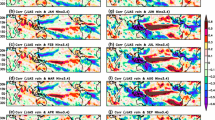Abstract
By means of monthly mean NCEP/NCAR data analyses, this note investigates the lag influences of winter circulation conditions in the tropical western Pacific on South Asian summer monsoon through the methods of composite, correlation and statistical confident test. The results indicate clearly that winter climate variations in the equatorial western Pacific would produce significant influences on the following South Asian summer monsoon, and with the lapse of time the lag influences show clearly moving northward and extending westward features. When winter positive (negative) sea level pressure anomalies occupy the equatorial western Pacific, there is an anticyclonic (cyclonic) circulation anomaly appearing in the northwestern Pacific. With the lapse of time, the anticyclonic (cyclonic) circulation anomaly gradually moves to northeast, and its axis in the west-east directions also stretches, therefore, easterly (westerly) anomalies in the south part of the anticyclonic (cyclonic) circulation anomaly continuously expand westward to the peninsula of India. Undoubtedly, the South Asian summer monsoon is weak (strong).
Similar content being viewed by others
References
Blanford, H. F., On the connection of Himalayan snowfall with dry winds and seasons of drought in India, Proc. Roy. Soc. London, 1884, 37: 3.
Walker, G. T., On the meteorological evidence for supposed changes of climate in India, Mem. Indian, Meteor., 1910, 21: 1.
Hahn, D. J., Shukla, J., An apparent relationship between Eurasian snow cover and Indian monsoon rainfall, J. Atmos. Sci., 1976, 33: 2461.
Huang Ronghui, Li Weijing, Influence of the heat source anomaly over Asia, Proceedings of the International Conference on the General Circulation of East Asia, Chengdu, April 10–15, 1987, 40–51.
Huang Ronghui, Sun Fengying, Impact of the tropical western Pacific on the East Asian summer monsoon, J. Meteor. Soc. Japan, 1992, 70: 243.
Nitta, T., Convective activities in the tropical western Pacific and their impact on the Northern Hemisphere summer circulation, J. Meteor. Soc. Japan, 1987, 65(3): 373.
Li Chongyin., Frequently strong activity of trough over East Asia and generation of El Nino, Sciences in China (in Chinese) Ser. B, 1988, 18: 667.
Li Chongyin, Interaction between anomalous winter monsoon in East Asia and El Nino events, Adv. Atmos. Sci., 1990, 7: 36.
Wang, B., Wu, R., Lukas, R., Roles of the western North Pacific wind variation in thermocline adjustment and ENSO phase transition, J. Meteor. Soc. Japan, 1999, 77(1): 1.
Wang, B., Wu, R., Fu, X., Pacific-East Asian teleconnection: how does ENSO affect East Asian climate? International Workshop on the Western Pacific Warm Pool and Monsoon (WPM), Huangshan, August 24–28, 1999, 23–25.
Anderson, S. P., Weller, R. A., Surface buoyancy forcing and the Mixed layer of the western Pacific warm pool: observations and 1D model results, J. Climate, 1996, 9: 3056.
Webster, P. J., Yang, S., Monsoon and ENSO: Selectively interactive system, Quart. J. R. Meteorol. Soc, 1992, 118: 877.
Author information
Authors and Affiliations
Corresponding author
About this article
Cite this article
Wu, B., Huang, R. Lag influences of winter circulation conditions in the tropical western Pacific on South Asian summer monsoon. Chin.Sci.Bull. 46, 858–861 (2001). https://doi.org/10.1007/BF02900439
Received:
Issue Date:
DOI: https://doi.org/10.1007/BF02900439




